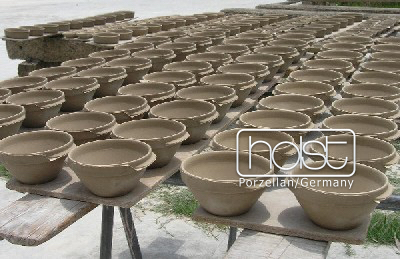Drying process

Before the porcelain firing - after the shaping - the soft porcelain mass must dry in order to pass the article to the next production phase. This process is often erroneously called "drying out", but this is not entirely correct due to the amount of moisture still present afterwards - at least in purely physical terms. The fact is that the porcelain must be "leather-hard" for further processing in the II. production stage, so that it can be transferred to the next production stage. Climatically, European factories, especially the German and Eastern European porcelain industry, have a locational disadvantage because the ambient heat is not sufficient to bring the porcelain into the desired leather-hard state.
From the knowledge of raw materials we know that porcelain is made of inorganic minerals of different composition, hardness and plasticity. In the conventional processes (jiggering, casting, rolling, pressing) water serves as a binder, in the isostatic process special binding agents have to be added to the granulate.
During the drying and firing process, the porcelain loses up to 25% of its size due to the removal of water. This process is called shrinkage. The more time is given to this process, the better. After shaping, porcelain behaves similar to yeast dough: it simply needs time to mature! Drying or pre-drying is of great importance in this process.
In many cases, drying chambers, irradiation ovens or heat lines are used to carry out the initial drying. In Asia at temperatures of 40 °C and more, the sun can be used as a natural drying source: After just a few hours, the porcelain is cured to the stage of further processing.
